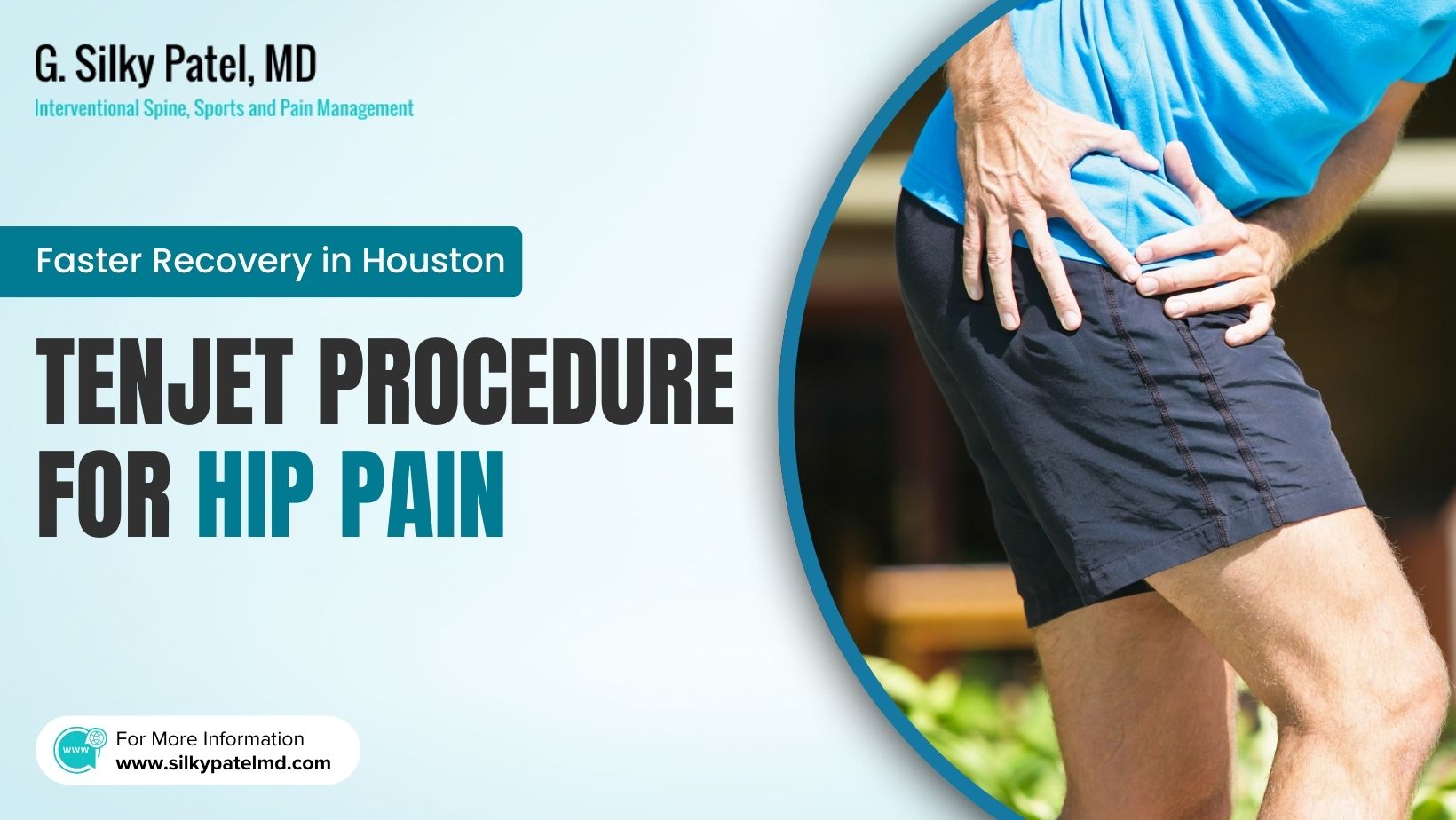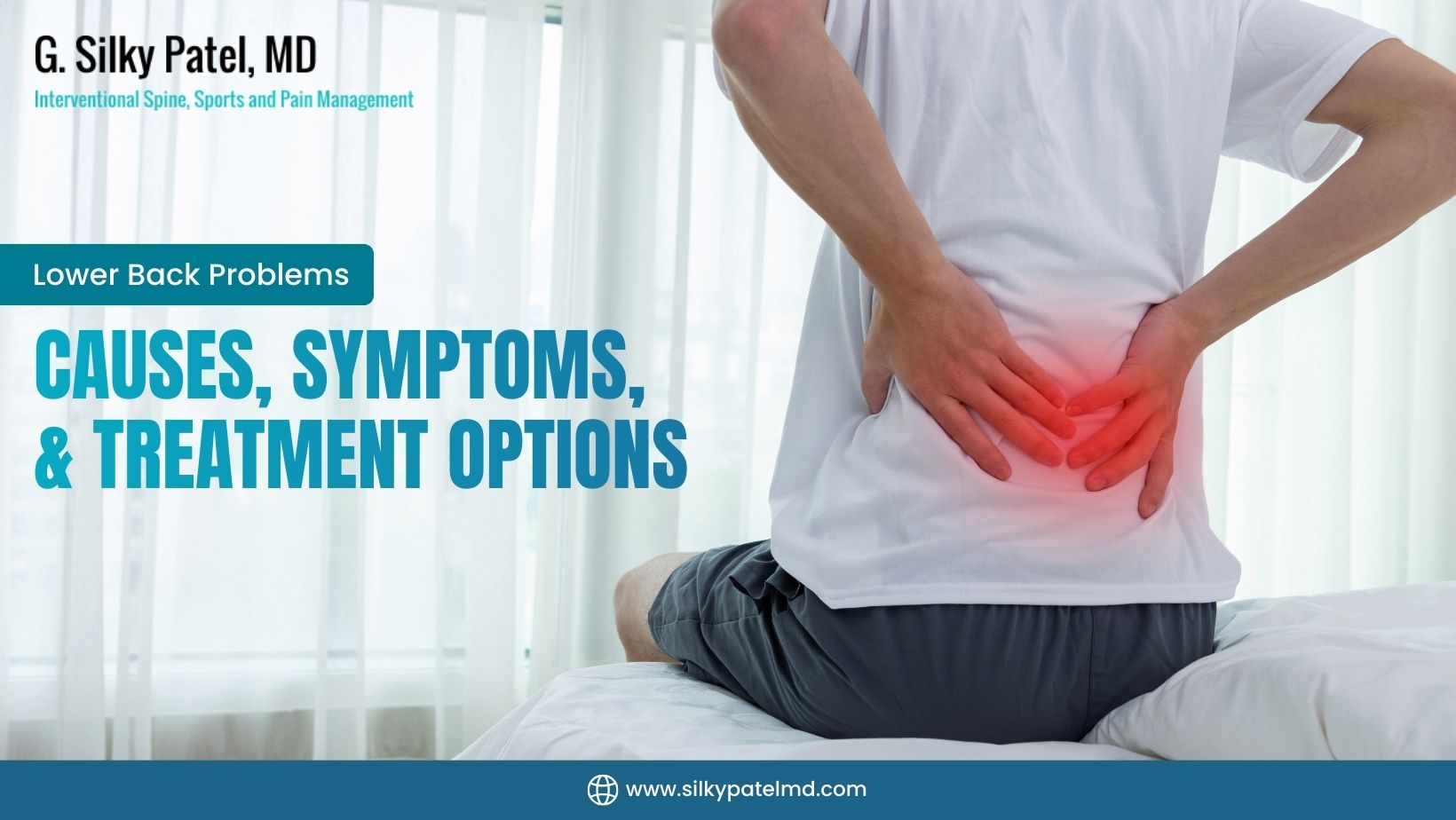Table of Contents
ToggleTenJet procedure hip pain is becoming one of the most talked-about solutions for people in Houston who are struggling with stubborn tendon-related discomfort around the hip. Many individuals live with ongoing lateral hip pain, often linked to gluteal tendinopathy, hamstring irritation, or repetitive strain from sports and daily activities. When simple measures such as rest, medications, or physical therapy fall short, the frustration can grow quickly. That is when a minimally invasive option like TenJet begins to stand out.
The hip joint plays a central role in movement, balance, and stability. Pain in this region can limit your ability to walk, climb stairs, or even sleep comfortably. Unlike temporary relief methods, TenJet treatment for tendinopathy and the TenJet procedure hip pain option directly target the diseased tissue responsible for chronic irritation. By addressing the root problem instead of just calming symptoms, it opens the door to lasting comfort and function.
Living in Houston’s active environment, where outdoor sports, fitness programs, and long commutes are a part of everyday life, many people need a solution that works fast. This is where the procedure’s design truly shines. The TenJet procedure hip pain patients receive is a minimally invasive hip pain treatment that allows you to return to daily activities quickly while avoiding the long recovery period often associated with surgery. Patients appreciate that it can be performed in an outpatient setting, requires only a micro-incision, and delivers precise results guided by ultrasound imaging.
When considering options for hip tendon pain, the TenJet procedure Houston patients are seeking stands out as both innovative and reliable. It bridges the gap between conservative treatments that do not always bring relief and major surgical approaches that involve long downtime. With the added expertise of Dr. Silky Patel, a double board-certified pain specialist who has helped countless individuals across Houston and nearby communities, this technique is transforming how hip pain is managed in modern medicine.
Understanding TenJet Procedure Hip Pain
To truly appreciate the benefits of TenJet procedure hip pain, it helps to first understand what happens inside a tendon when pain becomes chronic. Healthy tendons are strong and flexible, built to handle everyday loads. But over time, repetitive stress or poor healing can leave small areas of damaged tissue. This is especially common around the hip, where tendons like the gluteal and hamstring tendons are exposed to constant strain. These damaged fibers can cause long-lasting discomfort, swelling, and weakness.
What TenJet Is
The TenJet system uses a specialized needle-like instrument connected to ultrasound guidance. With pinpoint accuracy, it delivers a controlled, high-pressure stream of saline that breaks down and removes only the diseased tendon tissue. At the same time, it suctions out debris, leaving behind healthy tendon fibers to continue the healing process. This targeted approach is what sets TenJet treatment for tendinopathy and the TenJet procedure hip pain technique apart from traditional methods that often fail to address the actual source of pain.
Why It Suits Hip Pain
Tendinopathy in the hip area, including gluteal tendinopathy, proximal hamstring injuries, and iliopsoas tendon irritation, is notoriously difficult to treat. Stretching, injections, or rest may reduce discomfort temporarily, but the damaged tissue often lingers. The TenJet system provides a minimally invasive hip pain treatment and is part of the TenJet procedure hip pain approach that directly clears away unhealthy fibers while preserving the surrounding healthy structure. By doing so, it gives the tendon a chance to heal more effectively.
Comparing TenJet and Surgery
One of the greatest advantages of this approach is that it avoids the risks and extended downtime of open surgery. Traditional surgical debridement can require large incisions, stitches, and weeks of restricted activity. By contrast, TenJet recovery time is often measured in days, not months, and most patients return to light activities almost immediately. For those living and working in Houston, this faster timeline makes the TenJet procedure hip pain solution a realistic way to maintain routines without the prolonged interruption of a major operation.
Why Houston Patients Choose It
The TenJet procedure Houston patients are turning to offers more than pain relief; it restores confidence in movement. Walking through the city, commuting across busy highways, or even enjoying a jog at Memorial Park becomes less intimidating when tendon pain no longer dominates daily life. With precise image guidance and the skill of Dr. Silky Patel, patients not only find relief but also gain a solution tailored to their lifestyle and goals.
Minimally Invasive Hip Pain Treatment: Who Is A Candidate?
Not everyone with hip pain automatically needs the TenJet procedure hip pain approach, but for the right patient, it can be a game-changer. The best candidates are those who have lived with tendon-related pain for months or even years despite trying rest, medications, or physical therapy. When the body cannot fully repair itself, damaged tissue lingers, and that is when a more targeted solution becomes necessary.
Ideal Candidates
Many patients who benefit from TenJet treatment for tendinopathy have gluteal tendon pain, hamstring irritation, or iliopsoas issues that have not improved with standard measures. These individuals are often active people in Houston who want to regain their ability to walk, exercise, or sleep comfortably without persistent discomfort. Patients who want to avoid the risks and long downtime associated with open surgery often find this minimally invasive hip pain treatment, especially through the TenJet procedure hip pain pathway, to be a more appealing option.
When TenJet May Not Be Suitable
Like any procedure, there are situations where it may not be appropriate. If the tendon is completely torn or severely degenerated, surgery might still be necessary. Likewise, patients with significant hip arthritis may need a different strategy since joint disease requires a broader approach than tendon-specific treatment. Dr. Silky Patel carefully evaluates each case to make sure the treatment plan addresses the true source of discomfort.
Setting Expectations
While many patients experience relief within weeks, it is important to remember that tendons heal gradually. The TenJet recovery time varies depending on the individual’s age, activity level, and extent of tendon damage. Most patients can expect a noticeable improvement in pain and function, but Dr. Patel ensures each person understands their healing timeline before beginning the TenJet procedure hip pain plan. Setting realistic goals makes the recovery process smoother and more rewarding.
TenJet Treatment for Tendinopathy: Step-By-Step With Dr. Silky Patel
The TenJet procedure hip pain patients receive in Houston is designed to be straightforward, precise, and efficient. By combining ultrasound guidance with targeted tissue removal, the process addresses the root problem while avoiding unnecessary trauma to surrounding structures.
Ultrasound Mapping and Planning
The procedure begins with ultrasound imaging to identify exactly where the tendon damage lies. This step is essential because tendon pain often spreads beyond the initial injury, and precision matters. Dr. Silky Patel uses advanced imaging to create a roadmap that guides every step of the treatment.
Local Anesthesia and Micro-incision
After mapping, the area is numbed with local anesthesia. Instead of large cuts or stitches, the TenJet procedure Houston patients undergo involves a micro-incision about the size of a pinhole. This tiny opening allows the TenJet device to access the damaged tendon tissue with minimal disruption, making the TenJet procedure hip pain process straightforward and effective.
Targeted Debridement and Suction
Once in place, the device releases a pressurized saline stream that breaks down diseased fibers. At the same time, suction removes the damaged tissue, leaving behind healthy fibers that can heal more effectively. This balance of removal and preservation is what makes TenJet treatment for tendinopathy so unique compared to traditional surgical methods.
Immediate Aftercare
After the procedure, the small opening is covered with a simple bandage. Most patients spend a short time in observation before returning home the same day. There are no stitches to manage, and post-procedure discomfort is usually mild. Because the process is minimally invasive hip pain treatment and part of the TenJet procedure hip pain strategy, patients can often return to light daily activities within a short period while their tendon begins the deeper healing process.
Why Patients in Houston Choose It
For individuals balancing work, family, and active lifestyles in Houston, TenJet recovery time is one of its biggest advantages. Instead of weeks on crutches or extended downtime, patients experience a much shorter healing curve. With Dr. Patel’s expertise, the TenJet procedure Houston residents trust combines innovation with compassionate care, making it a preferred solution for persistent tendon pain.
TenJet Recovery Time: What to Expect From Day 1 to Week 6 (and Beyond)
One of the biggest advantages of the TenJet procedure hip pain patients receive in Houston is the shorter recovery compared to open surgery. Instead of months of downtime, most individuals experience steady improvement over just a few weeks. Understanding the stages of TenJet recovery time helps patients set expectations and follow the right steps for long-term success.
The First 48 Hours
After the procedure, it is normal to feel soreness around the treated hip tendon. This discomfort usually feels more like post-exercise fatigue than sharp pain. Simple measures such as icing and avoiding overuse help during this period. Because it is a minimally invasive hip pain treatment and incorporated into the TenJet procedure hip pain approach, patients can usually walk the same day and return to basic activities of daily living without restrictions.
Weeks 1–2
During the first two weeks, patients are encouraged to begin gentle movement and light stretching. The tendon is still in its early healing stage, so avoiding high-impact exercise is important. With Dr. Silky Patel’s guidance, many patients begin incorporating controlled strengthening exercises to encourage tendon remodeling. The advantage of TenJet treatment for tendinopathy is that it clears damaged fibers, allowing healthy tissue to respond more effectively to progressive loading.
Weeks 3–6
As healing continues, activities are gradually increased. Walking longer distances, using stairs comfortably, and even light gym workouts can usually be reintroduced. Patients often report significant improvements in sleep quality, especially those who previously struggled to lie on the affected side. By the end of this stage, many people feel close to their normal routines and notice clear improvements in both strength and flexibility thanks to the TenJet procedure hip pain treatment.
Beyond 6 Weeks
Complete tendon healing can take several months, but by this stage most patients are functioning at a much higher level. They often return to sports, fitness training, or physically demanding jobs without the persistent limitations they experienced before. For those living in Houston’s active environment, this timeline makes the TenJet procedure Houston patients prefer a realistic way to balance recovery with busy schedules.
Results You Can Feel: Pain Relief, Function, and Durability
The TenJet procedure hip pain patients undergo is designed not only for short-term relief but also for durable results. By removing damaged tissue and preserving healthy tendon fibers, the treatment creates the conditions for long-term healing and improved function.
Typical Pain Relief Timeline
Most patients begin to notice decreased pain within the first few weeks, with steady improvement over several months. Because tendons remodel slowly, full results may continue to build over time. Unlike temporary measures, TenJet treatment for tendinopathy and the TenJet procedure hip pain process address the diseased tissue directly, which helps reduce the chance of recurring pain.
Functional Gains
Pain relief is only part of the equation. Improved mobility and strength allow patients to reclaim daily activities that once felt difficult. Tasks like walking through Houston’s busy downtown, climbing stairs at work, or enjoying weekend workouts at the gym become achievable again. Many patients also report better sleep since hip tendon pain is a common cause of nighttime discomfort.
Long-Term Durability
One of the reasons patients choose this minimally invasive hip pain treatment is its long-term effectiveness. By clearing away degenerative fibers, the tendon is allowed to heal on a stronger foundation. This reduces the likelihood of repeated flare-ups compared to treatments that only mask symptoms. With proper rehabilitation and activity modification, the TenJet procedure hip pain method delivers results built to last.
Factors That Influence Outcomes
Every patient’s experience is unique. The extent of tendon damage, overall health, and commitment to rehabilitation all play roles in the outcome. With Dr. Silky Patel’s expertise in guiding recovery, patients are able to maximize results while minimizing setbacks. Combined with her advanced training in pain medicine, the TenJet procedure Houston residents trust delivers both relief and confidence in daily movement.
TenJet Procedure Houston: Why Choose Dr. Silky Patel
Choosing the right specialist makes a tremendous difference in the success of the TenJet procedure hip pain patients receive. In Houston, Dr. Silky Patel has earned recognition for her advanced skill in ultrasound-guided interventions and her dedication to improving the lives of patients with chronic tendon conditions.
Double Board Certification and Leadership
Dr. Patel is double board certified in Physical Medicine & Rehabilitation and Pain Medicine. Her academic and clinical leadership includes serving as Clinical Assistant Professor of Neurosurgery at UT–Houston Medical School and as Director of Pain Management at Houston Methodist West Hospital. These experiences give her unique insight into advanced therapies like TenJet treatment for tendinopathy and their role in helping patients regain function.
Precision with Ultrasound Techniques
The effectiveness of minimally invasive hip pain treatment relies heavily on precision. By using real-time ultrasound imaging, Dr. Patel ensures the TenJet device targets only the diseased tendon tissue, leaving healthy fibers untouched. This accuracy is what makes the TenJet procedure hip pain solution highly effective while minimizing risk.
Serving Houston and Surrounding Areas
Patients across Houston and nearby communities such as Katy, Sugar Land, Memorial, Cypress, Pearland, Spring, and The Woodlands travel to see Dr. Patel for this innovative approach. Whether someone is an athlete, a busy professional, or simply wants to return to pain-free living, the TenJet procedure Houston residents turn to is available close to home with the expertise of Dr. Patel.
Preparing for Your Visit: Simple Next Steps
Getting ready for the TenJet procedure hip pain treatment involves only a few straightforward steps. Dr. Patel and her team focus on making the process clear, comfortable, and customized for each patient.
What to Bring
Patients should bring any prior imaging studies, a list of medications, and details about their activity limitations. These pieces of information help Dr. Patel create a personalized treatment plan. Because TenJet treatment for tendinopathy works best when the exact source of pain is defined, these details are key to building an effective roadmap.
How Dr. Patel Tailors the Plan
Every patient is different, and that is why Dr. Patel performs a thorough evaluation before recommending the procedure. Using ultrasound imaging and a hands-on examination, she pinpoints the diseased tendon tissue and determines whether a minimally invasive hip pain treatment will deliver the best outcome. This careful process ensures that the TenJet procedure Houston patients choose is truly suited to their condition and reflects the goals of the TenJet procedure hip pain approach.
Logistics and Comfort
On the day of the procedure, patients can expect a simple outpatient experience. Parking and check-in are straightforward, and most individuals return home within hours. The recovery instructions are easy to follow, and with the short TenJet recovery time, many patients are back to their routines quickly, supported every step of the way by Dr. Patel’s guidance.
Smart Alternatives and Complements to TenJet for Hip Pain
While the TenJet procedure hip pain patients seek offers a powerful solution, some cases may require additional approaches to support long-term tendon health. Dr. Patel often combines advanced interventions with supportive strategies for the best results.
Targeted Physical Therapy
Even after TenJet treatment for tendinopathy, tendons respond best when they are gradually strengthened. Customized therapy programs help patients rebuild flexibility and resilience. This step reduces the risk of recurring irritation and enhances the benefits of the procedure.
Image-Guided Injections and Biologic Options
For certain patients, image-guided injections or biologic treatments may be used alongside or instead of TenJet. These options can reduce inflammation or promote natural healing. With Dr. Patel’s expertise in precision techniques, these methods complement minimally invasive hip pain treatment strategies and may be combined with the TenJet procedure hip pain program.
Lifestyle Adjustments
Simple changes in daily movement patterns, posture, and exercise routines can protect the healing tendon. Whether it’s adjusting workouts at a Houston gym or modifying how one sits during long commutes, these small adjustments help extend the results. With consistent care, patients experience not just faster recovery but also long-lasting relief.
A Note From Dr. Silky Patel
Living with hip tendon pain can be overwhelming, especially when it interferes with your work, fitness, and family life. Over the years, I have seen countless patients struggle after exhausting conservative care without real improvement. That is why I am so passionate about offering the TenJet procedure hip pain patients across Houston are now discovering. This advanced technique allows me to directly target the diseased tendon tissue, relieving pain while protecting the healthy structure that supports your movement.
The precision of ultrasound guidance combined with the minimally invasive nature of this procedure gives patients a pathway to faster recovery and long-lasting results. I take pride in tailoring every treatment plan to the unique needs of each individual, whether you are an athlete, a professional balancing long workdays, or simply someone who wants to enjoy walking without discomfort through the TenJet procedure hip pain method.
My goal is always to restore function and improve quality of life. If you are considering TenJet treatment for tendinopathy or want to explore a minimally invasive hip pain treatment, I would be honored to walk with you on this journey toward healing. Together, we can find the right balance between advanced technology and personalized care to get you moving forward again.




